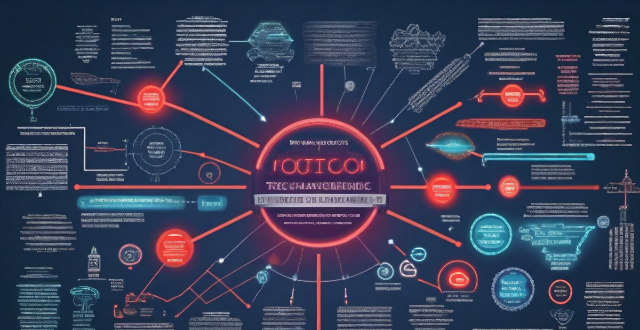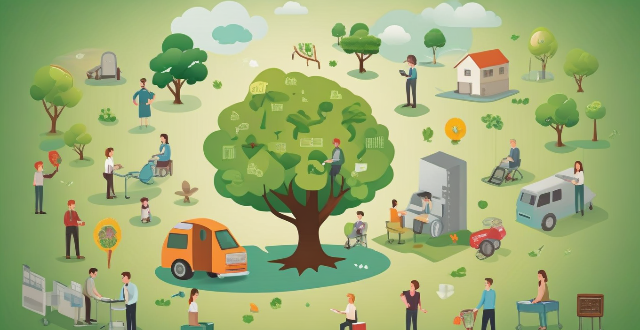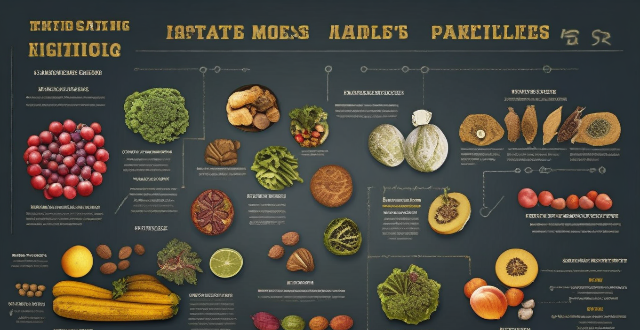Sustainable Need

What are the main sources of sustainable energy ?
The text discusses the various main sources of sustainable energy, including solar energy, wind energy, hydropower, geothermal energy, bioenergy, tidal and wave energy, and hydrogen energy. It also highlights the importance of adopting sustainable energy for environmental impact, economic benefits, energy security, and health considerations. The transition to sustainable energy requires investment, policy support, and technological innovation.

How can I incorporate sustainable fashion into my lifestyle ?
Incorporating sustainable fashion into your lifestyle is essential for preserving the environment and promoting fair labor practices. To do so, educate yourself on sustainable brands and fast fashion's impact, support ethical and sustainable brands, reduce consumption by practicing mindful shopping and creating a capsule wardrobe, maintain and care for your clothes properly, recycle or donate old clothes, and advocate for change by using your voice and engaging with brands.

What is the importance of sustainable agriculture in achieving the Sustainable Development Goals ?
Sustainable agriculture is crucial for achieving the United Nations' Sustainable Development Goals by ensuring food security, improving rural livelihoods, and protecting the environment. It promotes soil health, increases crop yields, encourages biodiversity, creates jobs in rural areas, enhances income, promotes gender equality, reduces greenhouse gas emissions, conserves water resources, prevents land degradation, supports climate change mitigation and adaptation, stimulates economic growth, and reduces poverty. By adopting sustainable agriculture practices, we can create a more equitable and resilient world for future generations.

How do climate-friendly products contribute to sustainable development ?
The article discusses the importance of climate-friendly products in sustainable development. These products help reduce greenhouse gas emissions, conserve natural resources, support renewable energy sources, and encourage eco-friendly lifestyles. By using less energy or producing fewer pollutants during their production, use, and disposal, these products contribute to a healthier planet for future generations. Examples include energy-efficient appliances, electric vehicles, reusable water bottles made from recycled materials, bamboo toothbrushes, solar panels, wind turbines, hydroelectric generators, cloth shopping bags, and compostable food containers. As consumers become more aware of the environmental impact of their choices, they can make informed decisions that support a more sustainable future.

What challenges do we face in achieving a continuous supply of sustainable energy ?
The challenges to achieving a continuous supply of sustainable energy include technological limitations, economic barriers, political and social factors, infrastructure and grid integration issues, and environmental impacts. Addressing these challenges requires collaboration between governments, businesses, and individuals to work towards a more sustainable future for our planet.

How does resource-efficient utilization contribute to sustainable development ?
Resource-efficient utilization is key to sustainable development, conserving resources, reducing waste, and promoting economic growth. It helps mitigate environmental impact, provides economic benefits, and enhances social well-being. As we face global challenges like climate change and resource scarcity, adopting resource-efficient practices is crucial for a sustainable future.

What are the challenges to achieving sustainable consumption ?
The text discusses the various challenges to achieving sustainable consumption, including lack of awareness and education, economic barriers, cultural and social norms, infrastructure and accessibility issues, technological limitations, policy and regulatory challenges, business practices, and consumer behavior. It emphasizes the need for a multifaceted approach involving education, policy changes, technological advancements, and cultural shifts towards more sustainable consumption patterns to overcome these challenges and move towards a more sustainable future for all generations.

How can businesses contribute to sustainable consumption ?
Businesses can contribute to sustainable consumption by adopting circular economy principles, managing green supply chains, using eco-friendly packaging, practicing product stewardship, improving energy efficiency, conserving water, engaging in responsible marketing, promoting innovation, engaging stakeholders, and supporting environmental initiatives. These practices help reduce waste, minimize resource use, and inspire sustainable consumer behavior.

What role do consumers play in promoting sustainable consumption ?
The article explores the role of consumers in promoting sustainable consumption. It emphasizes the importance of education and awareness, reducing waste, reusing items, recycling materials, supporting sustainable businesses, and advocating for change as key strategies for consumers to contribute to sustainable consumption. The article highlights the significance of these strategies in reducing environmental impact and conserving resources for a more sustainable future.

Is it ethical to engage in deforestation for agricultural purposes ?
Is it ethical to engage in deforestation for agricultural purposes? This question requires a nuanced understanding of both environmental ethics and the needs of agriculture. The case against deforestation includes loss of biodiversity, climate change, and soil erosion and water quality issues. However, the case for agricultural deforestation includes food production, economic opportunities, and sustainable practices. To navigate the ethical implications of deforestation for agriculture, a balanced approach is crucial, including reducing new land needed, regenerative agriculture, agroforestry, policy and regulation, and public awareness. While the need for agricultural land is pressing, engaging in deforestation without considering its broader ecological consequences is not ethically sustainable. It is essential to find ways to meet our agricultural needs while also preserving the integrity of our planet's ecosystems. By promoting sustainable agriculture and implementing protective measures, we can move towards a future where food production and forest preservation coexist harmoniously.

What role does waste reduction play in sustainable development ?
The article discusses the importance of waste reduction in sustainable development. It highlights the environmental, economic, and social benefits of waste reduction, including conservation of natural resources, protection of ecosystems, climate change mitigation, cost savings, job creation, innovation and efficiency, public health, education and awareness, and community engagement. The article emphasizes that waste reduction is an essential component of sustainable development and encourages individuals, businesses, and governments to take action to reduce waste.

Can sportswear companies produce more sustainable products ?
Sportswear companies can produce more sustainable products by using eco-friendly materials, reducing waste, and adopting circular economy principles.

How do climate change and sustainable development goals (SDGs) intersect ?
The intersection of climate change and sustainable development goals (SDGs) is crucial for creating a sustainable future. Climate change affects all aspects of sustainable development, from health and well-being to clean water and sanitation to affordable and clean energy. To effectively address climate change within the context of sustainable development, it is important to integrate climate actions into each SDG through strategies such as integrated planning, finance and investment priorities, and education and awareness campaigns. By doing so, we can work towards a more sustainable future for our planet.

How do clean production technologies contribute to sustainable development ?
Clean production technologies are vital for sustainable development as they reduce environmental impact, conserve resources, and foster economic growth. They minimize pollution, preserve biodiversity, enhance resource efficiency, promote economic benefits, and advance social well-being. By adopting these technologies, societies can achieve a more sustainable future that balances environmental integrity, economic growth, and social equity.

How does sustainable consumption impact the economy ?
Reduced resource depletion, lower energy costs, increased innovation, and improved public health are some of the key benefits of sustainable consumption. While there may be short-term costs associated with transitioning to more sustainable practices, the long-term benefits far outweigh these costs.

How can sustainable investing help achieve the United Nations Sustainable Development Goals ?
Sustainable investing, which incorporates environmental, social, and governance criteria into investment decision-making, can significantly contribute to achieving the United Nations Sustainable Development Goals. It promotes environmentally friendly practices, enhances social well-being, advances economic growth and innovation, upholds good governance and partnerships, drives market trends towards sustainability, and attracts conscience-driven consumers. By aligning financial objectives with positive societal impact, sustainable investing creates a framework for long-term, sustainable growth that benefits people, planet, and profit.

How much sunlight do indoor plants need ?
Indoor plants require sunlight for photosynthesis, but the amount needed varies by species. General guidelines include low light tolerance for plants like Peace Lily and Snake Plant, medium light requirements for Dracaena and Pothos, and high light preference for Cacti and Succulents. Key considerations involve window orientation and artificial lighting. Success tips include researching plant needs, monitoring response, and gradual adjustment to new lighting conditions.

How can climate cooperation contribute to sustainable development goals ?
Climate cooperation plays a crucial role in achieving the United Nations' Sustainable Development Goals (SDGs), which aim to ensure that all people have access to the resources they need to live healthy, productive, and sustainable lives. By working together on climate action, nations can make significant progress towards several SDGs, including those related to poverty, hunger, health, education, gender equality, clean water and sanitation, affordable and clean energy, economic growth, and partnerships for the goals. Climate cooperation helps reduce the impacts of extreme weather events, natural disasters, and climate change on vulnerable communities, thereby contributing to poverty eradication efforts. It supports sustainable agricultural practices and promotes resilient food systems, ensuring food security and nutrition for all. Climate action helps reduce air pollution and improve public health outcomes, contributing to better respiratory health and overall well-being. Engaging women and girls in climate actions promotes gender equality by providing opportunities for leadership and participation in decision-making processes. Climate cooperation helps protect water resources from climate-related hazards, ensuring access to clean water and sanitation for all. Collaborative efforts in renewable energy research, development, and deployment contribute to universal access to affordable, reliable, and modern energy services. Climate cooperation creates green jobs and promotes sustainable economic growth, particularly in industries such as renewable energy and sustainable agriculture. Partnerships formed through climate cooperation drive innovation in sustainable technologies and infrastructure, fostering industrial development while minimizing environmental impacts. By addressing climate change, which disproportionately affects marginalized communities, climate cooperation helps reduce social and economic inequalities both within and among countries. Climate actions support urban planning and management that enhances inclusivity, resilience, and environmental sustainability in cities and human settlements. Climate cooperation encourages responsible consumption patterns and sustainable production methods, reducing waste and environmental degradation. This goal is directly linked to climate cooperation as it involves taking urgent action to combat climate change and its impacts. Through ocean conservation and sustainable fishing practices, climate cooperation helps protect marine ecosystems and biodiversity. By promoting sustainable land use and forest management, climate cooperation contributes to the conservation of terrestrial ecosystems and biodiversity. Climate cooperation builds peaceful societies and effective governance structures capable of managing environmental challenges and conflicts arising from resource scarcity. Climate cooperation itself is a form of international partnership that leverages collective action to achieve the SDGs more effectively. In conclusion, climate cooperation is not only essential for mitigating the effects of climate change but also for advancing the broader agenda of sustainable development. By integrating climate actions into national policies and international collaborations, we can work towards a future where environmental protection, social equity, and economic prosperity are mutually reinforcing goals.

How do climate model predictions inform sustainable development goals ?
Climate model predictions are vital for guiding sustainable development goals (SDGs) by providing insights into future climate conditions. They help project future climate scenarios, assess risks and vulnerabilities, support policy decisions, promote cross-sectoral collaboration, and enhance public awareness. By using these predictions, policymakers can make informed decisions that promote sustainability and resilience, contributing to the achievement of the United Nations' 2030 Agenda for Sustainable Development.

What are some innovative ways to generate sustainable energy ?
The article discusses various innovative ways to generate sustainable energy. These methods include solar power, wind power, hydropower, geothermal energy, biomass energy, and wave energy, each with their unique techniques and systems.

How can we create a sustainable economy that benefits both people and the planet ?
To create a sustainable economy that benefits both people and the planet, several strategies must be employed. These include shifting to renewable energy sources, promoting circular economy practices, encouraging green innovations and technology, implementing sustainable agriculture practices, supporting local economies and fair trade, and raising awareness and education about sustainability. By taking these steps, we can ensure the well-being of current and future generations while minimizing waste, reducing environmental impacts, and conserving natural resources.

What challenges need to be overcome to create a sustainable lunar base ?
Building a sustainable lunar base presents significant challenges in logistics, environment, technology, and human factors. These include reliable transportation, remote construction, surviving extreme conditions, power generation, effective communication, habitability concerns, health care, and team dynamics. Addressing these issues will require innovative solutions and international collaboration, ultimately paving the way for deeper space exploration.

How do I choose a sustainable investment fund ?
Choosing a sustainable investment fund requires careful consideration of various factors, including your investment goals, the fund's ESG criteria and performance history, the experience of the fund manager, the fund's holdings and alignment with your values, fees and expenses, and ongoing monitoring of your investment. By following these steps, you can select a sustainable fund that aligns with your financial goals and personal values.

How does climate financing work to promote sustainable development ?
Climate financing plays a crucial role in promoting sustainable development by providing the necessary financial resources for projects and policies that aim to mitigate climate change and adapt to its impacts. It works through defining climate financing, identifying sources of climate finance, establishing mechanisms for climate finance, promoting sustainable development, and addressing challenges and considerations. Climate finance can come from various sources, including public and private sectors, international organizations, and even individual contributions. Several mechanisms have been established to channel climate finance effectively, such as the Green Climate Fund (GCF), Global Environment Facility (GEF), and Climate Investment Funds (CIF). Climate finance promotes sustainable development by funding projects that align with the United Nations Sustainable Development Goals (SDGs), particularly those related to clean energy, sustainable communities, and responsible consumption and production. Challenges such as ensuring adequate funding, maintaining transparency, and achieving equitable distribution of resources must be addressed. In conclusion, climate financing is an essential tool for driving sustainable development by supporting initiatives that combat climate change while promoting economic growth and social well-being.

What are the risks of sustainable investing ?
Sustainable investing carries risks such as inconsistent screening criteria, limited investment opportunities, higher costs, regulatory and legal issues, market risks, and reputational risks. Investors should carefully consider these risks before making investment decisions to ensure that sustainable investing aligns with their goals and risk tolerance.

What impact have celebrities had on promoting sustainable fashion ?
### Summary: Celebrities significantly influence sustainable fashion promotion by raising awareness, shaping trends, supporting eco-friendly brands, driving industry changes, and setting personal examples of sustainability. Through campaigns, social media engagements, and public appearances in sustainable fashion, they encourage followers to adopt more environmentally conscious choices. Their actions not only increase the visibility of sustainable brands but also push for greater transparency and ethical practices within the fashion industry.

What are the benefits of using sustainable energy sources ?
Using sustainable energy sources provides environmental, economic, and social benefits. These include reduced greenhouse gas emissions, improved air quality, conservation of natural resources, protection of ecosystems, cost savings, job creation, energy independence, stable energy prices, improved public health, community resilience, education and innovation, and increased energy access. Transitioning to sustainable energy is essential for our future prosperity and survival.

How can we ensure that the benefits of sustainable development reach everyone, including the most vulnerable groups ?
The text discusses how sustainable development can be ensured to reach everyone, including the most vulnerable groups. It suggests a multifaceted approach that involves balancing economic growth, social inclusion, and environmental protection. The strategies include developing inclusive policies, ensuring access to opportunities like education and training, investing in sustainable infrastructure and accessible services, encouraging community engagement and advocacy, and implementing monitoring and accountability measures. By working together across sectors and levels of society, a more equitable and sustainable future can be built for all.

What are the benefits of sustainable consumption ?
The text discusses the benefits of sustainable consumption, which include environmental protection, economic benefits, social well-being, and ethical considerations. By making conscious choices about what we consume and how we dispose of our waste, we can reduce our carbon footprint, conserve natural resources, preserve biodiversity, save costs, create jobs, promote healthier lifestyles, ensure equitable distribution of resources, build community, protect animal welfare, support fair trade, and encourage transparency and accountability in businesses. Sustainable consumption is crucial for creating a more sustainable future for ourselves and future generations.

How does TCFD contribute to achieving the United Nations Sustainable Development Goals ?
The Task Force on Climate-related Financial Disclosures (TCFD) contributes significantly to achieving the United Nations Sustainable Development Goals (SDGs). The TCFD is a global initiative that aims to provide clarity and consistency in how companies report climate-related information. This initiative helps investors, lenders, insurers, and other stakeholders understand the risks and opportunities related to climate change. ### **How TCFD Supports the SDGs** #### **1. Promoting Transparency and Accountability:** The TCFD's framework encourages businesses to disclose their environmental impact, which aligns with SDG 12 (Responsible Consumption and Production) and SDG 17 (Partnerships for the Goals). By promoting transparency, TCFD supports businesses in becoming more accountable for their actions, thereby driving sustainable practices within industries. #### **2. Enhancing Risk Management:** Climate-related financial disclosures help identify and manage risks associated with climate change. This directly supports SDG 13 (Climate Action) by encouraging businesses to take proactive steps towards reducing their carbon footprint and adapting to climate change impacts. #### **3. Facilitating Investment in Sustainable Projects:** Through clear and consistent reporting standards, TCFD makes it easier for investors to identify companies committed to sustainability. This can lead to increased investment in projects that support various SDGs, such as renewable energy (SDG 7), clean water and sanitation (SDG 6), and sustainable cities and communities (SDG 11). #### **4. Driving Innovation:** By highlighting the need for companies to adapt to climate change, TCFD indirectly promotes innovation in clean technologies and sustainable business models. This aligns with SDG 9 (Industry, Innovation and Infrastructure) and SDG 12 by fostering innovative solutions that reduce environmental impact while maintaining economic growth. #### **5. Supporting Policy Coherence:** The TCFD's recommendations can guide policymakers in developing coherent policies that support both climate action and sustainable development. This aids in achieving SDG 17 by ensuring that policies are designed to support all SDGs simultaneously. ### **Conclusion** The Task Force on Climate-related Financial Disclosures plays a crucial role in advancing the United Nations Sustainable Development Goals by promoting transparency, enhancing risk management, facilitating sustainable investments, driving innovation, and supporting policy coherence. Through its work, TCFD helps bridge the gap between financial decision-making and environmental stewardship, making it an integral part of the global effort to achieve a sustainable future.